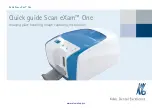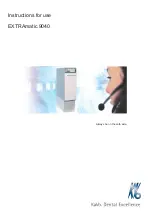
89
G20, 30, 40 SIIIA Operation & Maintenance Manual
CHECKS AND OPERATION AFTER START-UP
Check after the Engine Start-up
Check the following items in the engine warming-up
operation.
Engine noise and exhaust smoke color -
•
Listen to the engine and, if any abnormal noise is
heard, check to determine the cause.
•
Check the fuel combustion condition by observing the
exhaust smoke color. The exhaust smoke color after
engine warm-up and at no-load condition should be
colorless or light blue.
•
Black or white smoke indicates incorrect combustion.
Note: After start-up from cold the engine might be
noisier and the exhaust smoke color darker
than when it has warmed up. However this
condition will disappear after warm up.
Leakage in the systems -
Check the following items:
•
Lubrication oil leakage - Check the engine for oil
leaks, paying particular attention to oil filter and oil
pipe joints.
•
Fuel leakage - Check the fuel injection pump, fuel
lines and fuel filter for leakage.
•
Coolant leakage - Check the radiator and water pump
hose connections and the water drain cock on the
cylinder block for leakage.
•
Exhaust smoke or gas leakage
Checking coolant level
The coolant level could drop because any mixed air is
expelled in about 5 minutes after the engine started.
Stop the engine, remove radiator cap, and add coolant.
WARNING
Hot steam can rush out and you could get burnt if the
radiator cap is removed when the engine is hot.
Cover the radiator cap with a thick cloth and loosen
the cap slowly to reduce the pressure, then remove
the cap.
OPERATION AND CARE OF A NEW ENGINE.
Your engine is carefully tested and adjusted in the
factory, however, further run-in is necessary. Avoid any
harsh engine operation within the initial 100 operating
hours.
Do not operate the unit at full load until the engine is
warmed-up.
Do not allow the engine to run unloaded for extended
periods so as to minimise the risk of cylinder bore
glazing.
During operation, pay attention to the following points if
the engine shows any sign of abnormalities.
(1)
Engine Oil Pressure
- The engine oil pressure is
monitored by a switch that will stop the engine if the
pressure falls below a pre-set value.
(2)
Coolant Temperature
- The engine performance will
be adversely affected if engine coolant temperature
is too hot or too cold. The normal coolant
temperature is 75 to 85°C (167 to 185°F).
Overheating
CAUTION
If you see or hear escaping steam or have other
reason to suspect there is a serious overheat
condition, stop the engine immediately.
If the Engine Coolant Temperature gauge (where fitted)
shows an overheat condition, or you have reason to
suspect the engine may be overheating, take the
following steps:
Close the service valve to reduce the load.
Let the engine run at normal idle speed for two or three
minutes. If the engine coolant temperature does not start
to drop, turn off the engine and proceed as follows:
WARNING
To help avoid being burned -
•
Do not open the canopy or door if you see or
hear steam or engine coolant escaping. Wait until
no steam or engine coolant can be seen or heard
before opening the engine canopy or door.
•
Do not remove the radiator filler cap if the engine
coolant in the reserve tank is boiling. Also do not
remove the radiator filler cap while the engine
and radiator are still hot. Scalding fluid and
steam can be blown out under pressure if either
cap is taken off too soon.
Summary of Contents for G20 SIIIA
Page 2: ......
Page 4: ...4 G20 30 40 SIIIA Operation Maintenance Manual ...
Page 10: ...10 G20 30 40 SIIIA Operation Maintenance Manual ...
Page 15: ...15 G20 30 40 SIIIA Operation Maintenance Manual WARNING Flammable liquid ...
Page 20: ...20 G20 30 40 SIIIA Operation Maintenance Manual ...
Page 121: ......
















































